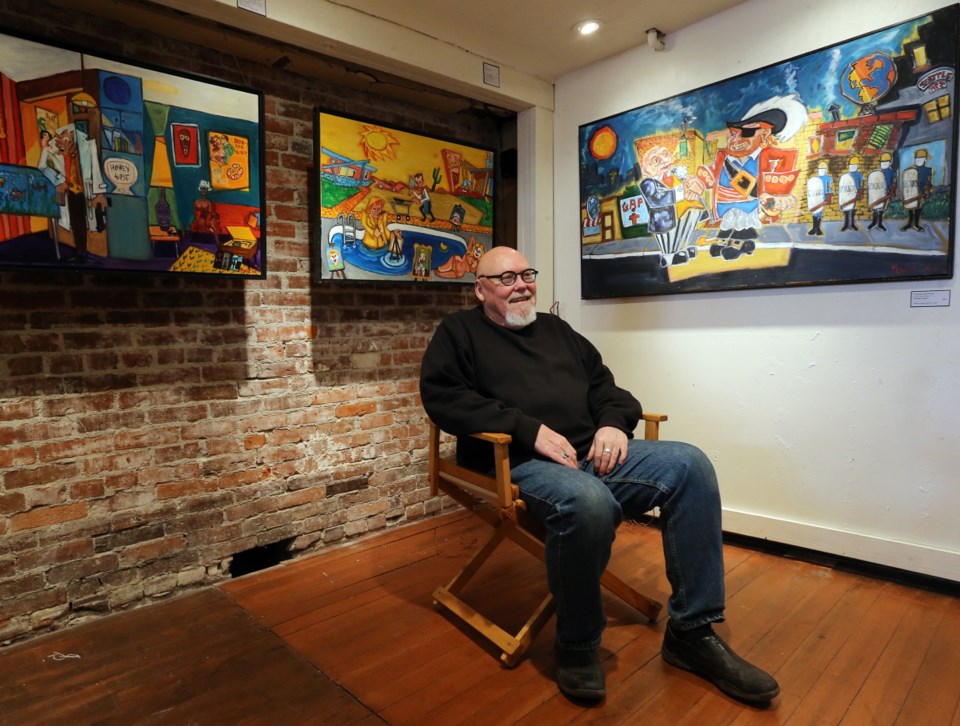Victoria has its own folk artist, someone working in an art style that he has largely invented, without reference to “fine art” training. His art might reasonably be termed naïve, primitive or “outsider,” though he isn’t any of those things. Like many folk artists, his work is narrative in content and strongly stated. His name is Michael Lewis.
A few facts help to explain the genesis of Michael Lewis’s practice. Lewis was born in Las Vegas, the child of a single mother who struggled to get by as an antique dealer. Much later he came to Victoria, where he worked as the night-desk clerk at Cool Aid, the original shelter for our street people. Painting erupted as a necessary reaction to that job.
“I’d come home with stories and my partner would say, ‘It’s not my world. I don’t want to deal with it!’ ” he confided to me. “And there are certain elements of confidentiality … so painting was a place to start putting my anxieties about those kind of things.”
His solitary therapy resulted in paintings of a side of our city never before seen in art, the urban myths and amazing tales that one doesn’t hear about behind the Tweed Curtain. Consider his richly toned oil on canvas, On The Rocks. “This is probably one of the older pieces,” Lewis began in a soft drawl, “a person who I had worked with at the hostel and they ended up in the harbour; presumably a suicide.” The figure is spread-eagled across the top of a tiny island in our harbour. Denise Nichols, who with her partner Gary Pearson curated this show, encouraged him to write little explanations for each piece. “One day a body washed up in the harbour,” he wrote. “At the time I knew his name. I’ve forgotten it now.”
The urban, contemporary side of Lewis’s life is shuffled in with his upbringing, steeped in the American culture of the years just before his time. He has always collected ephemera from the 1930s, ’40s and “a little bit of the ’50s,” he notes. Sunday funnies, comic books, lunch boxes, pulp novels, television programs — they’re all grist for his mill. “Even books,” he confesses. “Steinbeck … I wouldn’t want to live in the 1930s but I’m fascinated by it.” To a degree, he has always been the outsider, always searching for something — or someone — he lacked.
We considered two paintings of Dagwood Bumstead, the anti-hero of the Blondie comics. Dagwood, to this artist, represents the men who came out of the Second World War. “They were my father figures. Dagwood is not only a male doofus …” Lewis explained. “His behaviour erupts in incredibly violent fights with the postman, he’s always trying to get a nap during the day, and at night he’s awake making strange sandwiches. If he had been real he’d have gone through the Depression, gone through the war. Then he came back and tried to be so normal, married Blondie, had the kids, had the dog, had the suburban lifestyle and all of that. But the war stuff is still there, haunting him.”
We would call it post-traumatic stress disorder. “That wasn’t intended in the comics,” Lewis continued, “but that’s what I started to see.” In his painting, Mr. Dithers, his boss, plays Gen. McArthur; instead of a pinup of Betty Grable, we get Blondie; and Dagwood is storming the enemy lines alongside his neighbour, Herb Woodley. “People did go through the war together with the people they signed up with,” he noted. “You went in with your neighbours or friends.”
Another of his paintings is drawn from his own childhood. It takes place by the swimming pool of the Sands Hotel in Las Vegas. “My mother had a painting by a somewhat famous artist which we presumed was authentic.” She arranged to show it to Vincent Price and to Red Skelton, who were art collectors; she was too ill to go herself. So Lewis, then a teenager, met with both of them. “Neither was interested in purchasing the painting,” he recalled, “but I got to meet them.”
Skelton is shown up to his waist in the pool, wearing a yellow rain hat and slicker. “That’s how he kept his weight down,” Lewis explained. An amateur artist himself, Skelton is painting a voluptuous babe wearing, incongruously, sad clown makeup.
So many stories. There’s a painting of Popeye aboard a ship heading in to Sweet Haven, his home port, which in Lewis's hands looks like Sidney. “Actually, nobody else would see it, which often happens a lot,” Lewis admits, referring to the subtext of this painting. “It’s about me getting older, ruminating on final harbours, when the adventure is over.” The ferry boatman (played by Wimpy) will gladly accept payment on Tuesday for a hamburger today.
With his gentle manner and ready laugh, Lewis goes his own way. The paintings are inexpensive and not yet recognized by the tastemakers, but they are a true folk art of our time.
Michael Lewis: Striking Oil, at Dales Gallery, 537 Fisgard St., 250-383-1552, until Feb 26.
